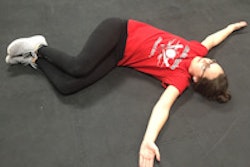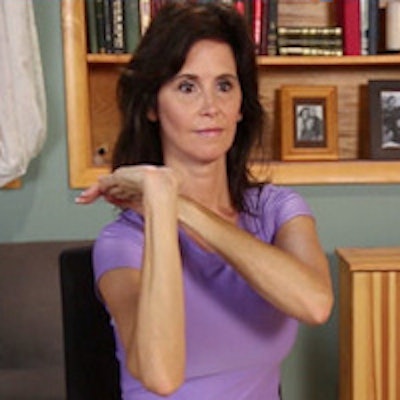
As sonographers, we wield a great deal of power, making a difference in the medical management of each person we work on. If you are not at 100%, you are doing a disservice to yourself as well as the patient. It's crucial to prioritize your mental and physical health.
One of the questions I ask myself when I'm with a patient is whether I'd be satisfied with my work if this were my mom or my dad. On busy days, it can be tough to reach that level, but it's always in the front of my mind, and it helps me be the best sonographer I can be.
We do a lot of work on LinkedIn, and I recently came across a great article there by Carson Tate, who is the founder and principal of management consultant firm Working Simply. In her article, originally published June 25 on FastCompany.com, Tate shares how she overcame the "busyness" of life, dealt with her fears, and worked to build a life that she lives fully.
Her words are powerful and had an immediate effect on both me and my colleague, strength and performance coach Mark Roozen (Coach Rozy). We both get caught up in the "busyness" of life, and it's always good to be reminded of what is truly important and to take the time to re-evaluate where you are. It's worth a read.
As Tate highlights in her article, it's vital to set the right priorities. If you are scanning in pain, you are not at your best and are discounting your patient and yourself. There is relief for my colleagues who scan in pain, but it's not something that can be solved quickly or just by taking a pill. There will need to be effort and education on your part.
Wrist and forearm pain
When speaking with different groups and at various events around the globe, we've had a number of folks with wrist and forearm pain approach us seeking information on what they can do to live pain-free. Below are a few ideas and what we call the "right moves" when beginning our program.
First, it's important to keep up with soft-tissue work. Thinking back to my days of gross anatomy (sometimes it's hard to remember back that far), the muscles of the forearm gave me the most trouble and were the hardest to learn and memorize. There are so many of them in a very small area.
Because sonographers use their lower arm repeatedly during long hours on the job, the forearms and wrists are common sites of serious nerve entrapment conditions such as carpal and ulnar tunnel syndromes.
If you have access to a technique known as active release, we highly recommend getting some maintenance work done on your elbows and forearms every three months or so. If you're unfamiliar with the active release technique (ART), it treats conditions related to the buildup of adhesions and scar tissue in muscles.
These adhesions can cause several problems: muscles become shorter and weaker, the motion of muscles and joints is altered, and nerves can become compressed. As a result, there is pain, decreased blood supply, and poor mobility in the affected tissues. When that happens, we have pain on the job and loss of work time -- which no one wants.
ART can help fix these issues by releasing trapped nerves and restoring the smooth movement of muscle fiber. You'll be amazed at what a difference it makes. All those little muscles love to bind together and cause trouble! By adding some stretches and active release techniques into your program, you can experience relief almost immediately.
Wrist and elbow flexibility
If we're going to focus on tissue quality with soft-tissue work, we also need to emphasize wrist flexibility. These three movements are a good way to start.
Wrist stretch
This stretching exercise improves flexibility and range of motion in the forearm, wrist, and fingers.
- Hold your right arm up in front of you (figure 1).
- With your left hand, grab the fingertips of your right hand.
- Slowly bring the fingers of the right hand back toward the forearm, applying gentle pressure to stretch out the wrist (figure 2).
- Hold for a set amount of time (see recommendations below).
- For the second movement, lightly apply pressure to the back of the right hand (figure 3).
- Repeat for the other wrist.
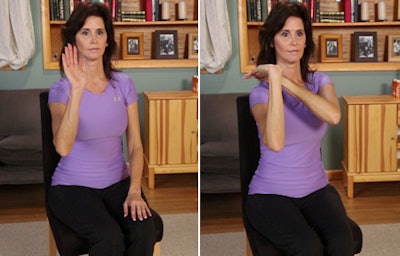 Figures 1 and 2. All images courtesy of Doug Wuebben and Mark Roozen.
Figures 1 and 2. All images courtesy of Doug Wuebben and Mark Roozen.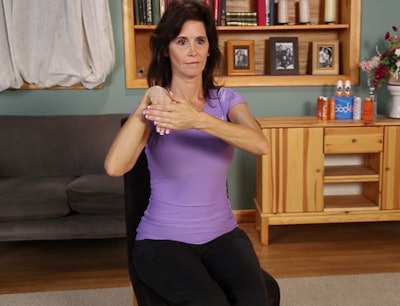 Figure 3.
Figure 3.Beginner: 2 x 20 seconds for each wrist, two times a week
Intermediate: 2 x 30 seconds for each wrist, two times a week
Advanced: 3 x 20 seconds for each wrist, two times a week
Spider stretch
This stretch will help you develop flexibility and mobility in the fingers and hands. You can do it standing or sitting, and it's an easy stretch to do anytime.
- Place your fingertips and thumbs together in front of you (figure 4).
- To begin the stretch, simply push the palms of the hands together while keeping tension on the fingertips (figure 5).
- The key here is not just to relax the fingers and bring the hands together. Keep the tension in the muscles of the hands and fingertips.
- Maintain for a set amount of time (see recommendations below).
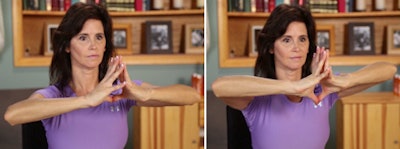 Figures 4 and 5.
Figures 4 and 5.Beginner: 1 x 20 seconds, two times a week
Intermediate: 1 x 30 seconds, two times a week
Advanced: 2 x 30 seconds, two times a week
Weight grip pinch
The weight grip pinch develops grip strength and forearm strength, and you can even work up to building shoulder strength.
- Grab two weighted objects that can be held (or pinched) together; the objects can be two books or two small weight plates, for example.
- To begin, grasp the two items with one hand.
- Start with the arm bent at the elbow to form a 90° angle (figure 6).
- Hold the resistance for a set amount of time (see recommendations below).
- To make the exercise more difficult, straighten your elbow and extend your arm, holding the objects farther away from the body. This will work your shoulder muscles as well as improve your grip strength.
- Switch to the other hand and repeat.
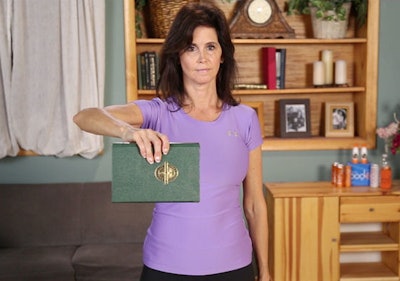 Figure 6.
Figure 6.Beginner: 2 x 20 seconds for each hand, two times a week
Intermediate: 2 x 30 seconds for each hand, two times a week
Advanced: 3 x 20 seconds for each hand, two times a week
Stop leaning/sleeping on your elbows
Medial elbow pain is the most common symptom of valgus extension overload, a series of elbow pathologies that Coach Rozy sees when working with his throwing athletes and lifters. One of the last in this pathology series is ulnar nerve entrapment, a condition that usually leads to numbness/tingling in the pinky and ring fingers.
Believe it or not, many people develop ulnar nerve problems not from sports and high-velocity throwing, but from excessively leaning on their elbows. So, if you're in the habit, stop! Likewise, radial nerve palsy has been nicknamed "Saturday night palsy" because it often occurs when individuals who might have enjoyed too many adult beverages fall asleep on their arms in awkward positions (imagine falling asleep with your arm over the back of a bench or couch).
Generally, the impingement occurs at the midportion of the upper arm, but the symptoms that develop typically include finger and wrist drop. If you sleep with your arms overhead and your head resting on your biceps, you might want to break the habit. Additionally, anyone on crutches should be cognizant of the problems that can arise in this regard.
If you use these simple guidelines and implement some of the basic movements into a routine two to three times a week, you can start to experience less pain and injury. To get more exercises, stretches, and movements that can help you live pain-free, email us at [email protected] and ask for a free copy of "The Right Moves" for wrists and arms.
Doug Wuebben is a registered echocardiographer and also a consultant, international presenter, and author of e-books in the areas of ergonomics, exercise and pain, and injury correction for sonographers. He has also been published on the topics of telemedicine and achieving lab accreditation. Mark Roozen is a certified strength and conditioning specialist, a certified personal trainer, and a fellow of the National Strength and Conditioning Association (NSCA). He has been in the strength, conditioning, and performance field for over 28 years. Wuebben and Roozen are co-founders of Live Pain Free -- The Right Moves. Email [email protected] or go to coachrozy.com for more information on programs or speaking requests or if you have any questions or comments.
The comments and observations expressed do not necessarily reflect the opinions of AuntMinnie.com.






